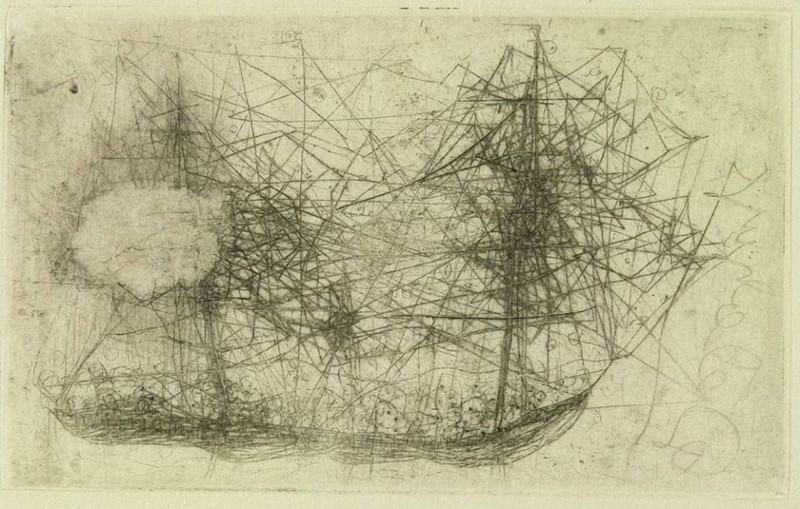Wols - Prints
30 Jul - 08 Sep 2013

Untitled (Schiff / Ship), 1955, Donated by Heinz Trökes
© VG Bild-Kunst, Bonn 2013 / © Photo: Staatliche Museen zu Berlin, Kupferstichkabinett / Fabienne Meyer
© VG Bild-Kunst, Bonn 2013 / © Photo: Staatliche Museen zu Berlin, Kupferstichkabinett / Fabienne Meyer
WOLS - PRINTS
On the Centenary of the Artist's Birth
30 July - 8 September 2013
An exhibition presented by the Kupferstichkabinett, Staatliche Museen zu Berlin, as part of the current collection display 'Divided Heaven - The Collection 1945-1968’
Born in Berlin 100 years ago as Alfred Otto Wolfgang Schulze, and known by his pseudonym from 1937 onwards, Wols was always an outsider whose work shared an affinity with late Surrealism and broke new ground, pioneering the gestural painting of Art Informel. His death in a Paris hotel room on 1 September 1951 marked the end of an eventful life. He had largely spent the previous two decades in France, where he emigrated after briefly training at a photographer’s studio in Dresden in the early 1930s. During the Second World War, he was persecuted as a German conscientious objector, imprisoned, and later had to flee for his life. After the war, he befriended the philosopher Jean-Paul Sartre and had his first exhibitions in Paris.
Wols’ art spanned painting, photography, drawing, and printmaking. As reflected in the 23 works presented here, most of his prints were drypoint etchings. They were made between 1948 and 1950, with only a few impressions of each printed, some as book illustrations. However, most of the impressions, including those on show here, were only pulled after his death in 1955. They were published by Gréty Wols, his widow.
The often extremely small etchings, originally carved into copper, are characterized by their distinctive miniature-like, fragile and yet resolute rendering. Each work hints at a miniature world held within it, alive with its own lyrical beauty. The works are richly evocative of natural forms, architectural structures, and organic shapes. But such associations only capture in part the richness of the linear structures, rendered with such precision and spontaneity. The same is true of the work titles, which were assigned at a later date.
The etchings were a donation presented by the artist Heinz Trökes, who was born, like Wols, in 1913. Two years before his death in 1997, Trökes presented the Kupferstichkabinett with 21 of his sketchbooks, as well as 34 drypoint etchings by Wols. The two artists had first met each other almost half a century before in Paris in 1949. Trökes’ 'Wamelner Series’ was presented to the Kupferstichkabinett in 1976. A selection of five etchings from his series are on display here as an 'overture’ to Wols’ works.
On the Centenary of the Artist's Birth
30 July - 8 September 2013
An exhibition presented by the Kupferstichkabinett, Staatliche Museen zu Berlin, as part of the current collection display 'Divided Heaven - The Collection 1945-1968’
Born in Berlin 100 years ago as Alfred Otto Wolfgang Schulze, and known by his pseudonym from 1937 onwards, Wols was always an outsider whose work shared an affinity with late Surrealism and broke new ground, pioneering the gestural painting of Art Informel. His death in a Paris hotel room on 1 September 1951 marked the end of an eventful life. He had largely spent the previous two decades in France, where he emigrated after briefly training at a photographer’s studio in Dresden in the early 1930s. During the Second World War, he was persecuted as a German conscientious objector, imprisoned, and later had to flee for his life. After the war, he befriended the philosopher Jean-Paul Sartre and had his first exhibitions in Paris.
Wols’ art spanned painting, photography, drawing, and printmaking. As reflected in the 23 works presented here, most of his prints were drypoint etchings. They were made between 1948 and 1950, with only a few impressions of each printed, some as book illustrations. However, most of the impressions, including those on show here, were only pulled after his death in 1955. They were published by Gréty Wols, his widow.
The often extremely small etchings, originally carved into copper, are characterized by their distinctive miniature-like, fragile and yet resolute rendering. Each work hints at a miniature world held within it, alive with its own lyrical beauty. The works are richly evocative of natural forms, architectural structures, and organic shapes. But such associations only capture in part the richness of the linear structures, rendered with such precision and spontaneity. The same is true of the work titles, which were assigned at a later date.
The etchings were a donation presented by the artist Heinz Trökes, who was born, like Wols, in 1913. Two years before his death in 1997, Trökes presented the Kupferstichkabinett with 21 of his sketchbooks, as well as 34 drypoint etchings by Wols. The two artists had first met each other almost half a century before in Paris in 1949. Trökes’ 'Wamelner Series’ was presented to the Kupferstichkabinett in 1976. A selection of five etchings from his series are on display here as an 'overture’ to Wols’ works.
